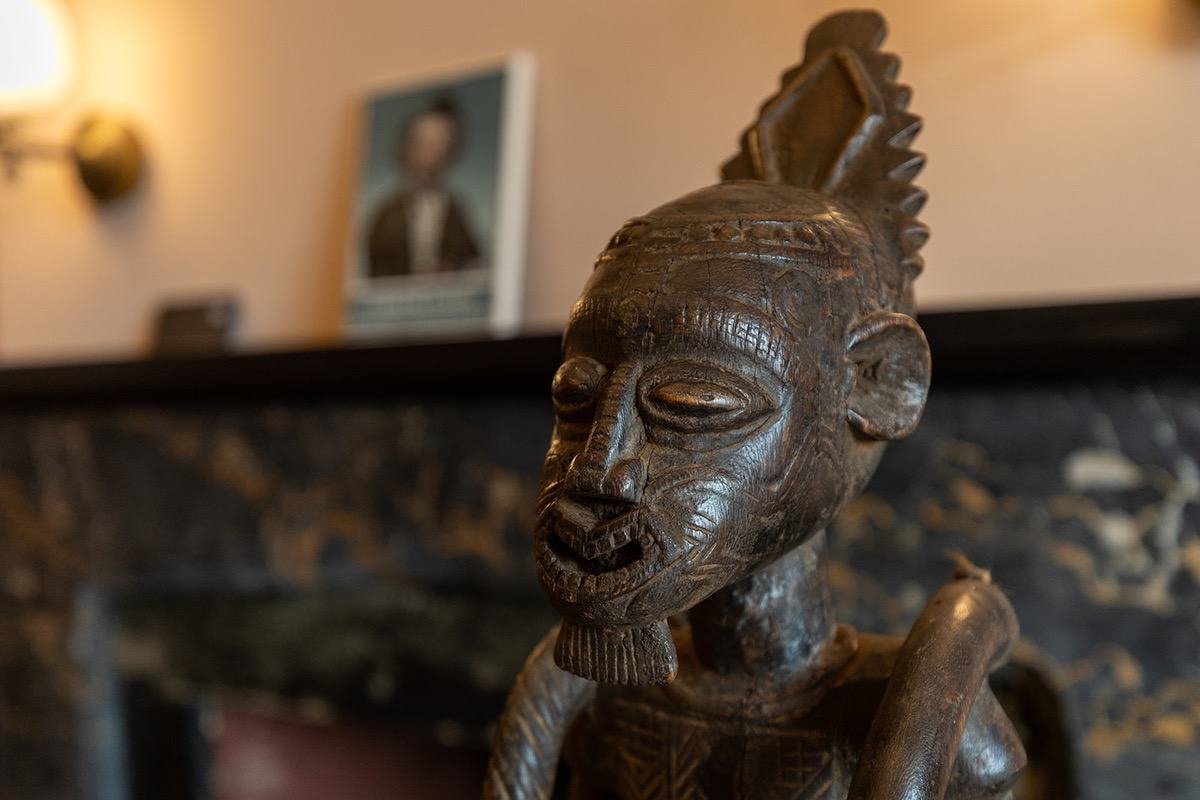Acclaimed West African artist Georges Adéagbo installs a new “portrait” at President Lincoln’s Cottage (Cottage Corner)
/President Lincoln’s Cottage (photo: Brian Rimm)
By Michael Atwood Mason
CEO & Executive Director, Lincoln’s Cottage
On January 17th, President Lincoln’s Cottage opened a new exhibition, Create to Free Yourselves: Abraham Lincoln and the History of Freeing Slaves in America by Georges Adéagbo, a renowned contemporary artist from Benin. President Lincoln’s Cottage preserves the home to connect people to the true spirit of the Lincolns, and we recognize that Abraham Lincoln means many different things to many different people.
When Georges requested to install his portrait of Lincoln at the Cottage while on a visit 2021 as a Smithsonian Artist Research Fellow, we were delighted. In the same way our staff fills the Cottage with stories from Lincoln’s time here, Georges has filled it with a visual story to invite visitors to explore their meanings about Lincoln.
He wanted to invite people to reflect on the importance of liberation in the place where Lincoln developed his ideas for the Emancipation Proclamation. Georges’s installation presents his unique and kaleidoscopic vision of Abraham Lincoln and the transformational impact he had on the lives of millions of people around the world. The installation invites each visitor to reflect on Georges’ vision of Lincoln—and their own.
A visitor takes in the installation at the opening. (Photo: Brian Rimm)
Georges explores many of the same themes that we do every day at the Cottage. He explores the love and grief in family life, creativity, leadership, and emancipation.
The installation also allowed us to collaborate with the Smithsonian’s National Museum of African Art and Howard University’s Chadwick A. Boseman College of Fine Arts. We were thrilled to support two paid internships for Howard art students, Mekbib Gebertsadik and Siah Prince, who assisted Georges throughout the installation process.
Georges Adéagbo (photo: Brian Rimm)
Who is Georges Adéagbo?
Georges Adéagbo is a strong and distinctive voice in contemporary art. Born in Cotonou, Benin, in 1942, Georges studied law and business administration in the 1960s. He began his artistic career when he returned to Benin after his father’s death in 1971.
Georges’ practice is characterized by installations that combine objects, images, and text as a form of personal reflection. Through the process of creation, he explores the interrelationships between objects and ideas in a continual circumambulation that raises new questions. Even the titles of Georges’s installations repeat key themes.
By the 1990s, Georges had received widespread acclaim in the art world. In 1999, he was the first African artist to win the prestigious Jury Prize at the famed Venice Biennale for a one-day installation titled “The Story of the Lion.” Since then, he has moved between Benin, Germany, and world-class contemporary art museums that have commissioned his installations in more than 17 countries. He regularly collaborates with curator Stephan Köhler.
Michael Mason, Mekbib Gebertsadik, Georges Adéagbo, Siah Prince, and Stephan Köhler. (Mekbib and Siah were the Howard University art students who assisted with the assembly, and Stephan is a curator who has worked with Georges for years.) (photo: Brian Rimm)
Although he recently turned 80 years old, Georges continues to explore and express his thoughts by writing and producing at least one temporary installation every day.
How does Georges Adéagbo create his installations?
Each installation emerges from a fluid interaction between an idea, a place, and the many objects that Georges Adéagbo collects, assembles, and stores. Multiple visits to the site allow Georges to imagine how he might utilize different surfaces and spaces to communicate his ideas.
A collection of the artwork (photo: Brian Rimm)
Prior to installing on site, Georges assembles many smaller, temporary installations to work through his ideas. Each provides him with the opportunity explore the interrelationships between individual elements—books, newspapers, handwritten signs, found objects, and artworks created by a team of artists in Benin.
Wherever Georges travels, he gathers objects for his personal collection, which he keeps in an archive at his studio in Benin. He collects materials that comment on, relate to, or amplify an idea or a site’s history or function. Each installation juxtaposes objects from the archive and the combinations frequently give rise to surprising implications.
For this installation, Georges visited thrift stores in Northern Virginia and the Georgetown Flea Market to find local objects that resonated with his themes.
Georges routinely takes objects from one place and installs them elsewhere, but he always thinks about the specificity of a site and establishes a network of associations between it and the objects in the installation.
For example, Georges has contrasted ancestral masquerades with images of an American ancestral figure to highlight a shared tradition of veneration that links Benin and the United States. While the formal aspects of these figures are quite different, they play a similar function connecting the past to the present, keeping the values and actions of those who have gone before present to the living.
Watch a time-lapse of the creation of one part of this installation over two weeks:
How to make sense of the installation?
Some people feel disoriented by Georges Adéagbo’s installations, but the density of objects invites you to enter a chain of associations. The artifacts provide you with the opportunity to discover and create connections involving motif, form, and theme. The link between the objects can produce meaningful associations across time and space. Even after hours of viewing, new relationships emerge.
(photo: Brian Rimm)
Georges particularly liked the installation on the mantle in the drawing room of the Cottage. In it, you immediately notice recurring images of riders and four-legged animals, though they have different forms and colors. According to Georges, the donkey represents democracy and is facing off against a figurine covering its eyes. He explained the significance, “Not everyone who considers themselves a democrat knows what democracy is.” Behind the donkey is Beninese Lincoln on horseback, inspired by the statue in front of the Cottage and commissioned especially for the installation. They are shown reflected in the mirror because Georges sees art is essentially reflective. Depending on where they stand, the faces of visitors also enter the installation in a dynamic way and pose the question of how to engage in the struggle for liberation in a democracy.
The installation will be on display from January 17 through February 15, 2023. Then, the installation will be taken down and packed up. It will either be shipped back to Georges, or it will be delivered to the Smithsonian’s National Museum of African Art.
Editor’s Note: This is the first in a series of articles by President Lincoln’s Cottage for a new column called “Cottage Corner.” Petworth News and the Cottage thought this would be a great way for the museum and national monument to reach out to the local community, and for you to get to know their special exhibits and what they have to offer.


























